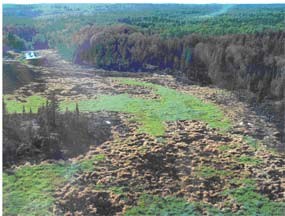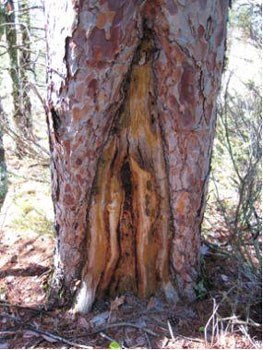
NPS When a fire burns through a landscape, topography, fuel, and weather combine to give each fire a unique burn pattern. This pattern produces a mixed landscape composed of different vegetation types and tree ages. The result is a landscape with tremendous diversity, an array of different plant species, and habitat for a wide variety of wildlife. The forested areas of the park depend on fire for a variety of functions. Fire removes brush, allowing light to reach the forest floor, and exposes the soil preparing a seedbed. This encourages growth of forest herbs and regeneration of new trees, such as red and white pine. Jack pine and upland black spruce both utilize heat from fire to melt resin that locks seeds inside cones. Once fire burns through an area the cones open and release their seeds. Aspen and birch are easily killed by fire, yet the species is persistent after a burn. The seeds of both species are easily transported by wind to distant sites. Aspen resprouts up to 100 feet from the original tree via the roots, and birch may resprout from the root collar at the base of the original tree. 
NPS The response of wildlife to fire varies by species; however, fire is essential to maintaining wildlife habitats in the long term. Most animals will sense fire and move away from approaching flames. Small mammals often escape fire by moving to areas outside the burn, unburned pockets within the fire, or retreating to burrows underground. The rejuvenating effects of fire attract different wildlife as well as fostering the emergence of new trees and vegetation. Woodpeckers are attracted to beetles that thrive on the fire killed trees soon after a burn. Snowshoe hare numbers often peak in the first 10-15 years after a fire and berry production increases within a few years after fire and attract many birds. 
NPS Prior to European settlement, most fires within the park occurred as a result of lightning. Within this natural fire regime, low intensity surface fires typically occurred every 10 to 40 years in white and red pine forests. Severe stand replacing fires occurred in jack pine and upland black spruce forests every 50 to 75 years. Severe fires also occurred in spruce/fir/aspen forests every 70 to 110 years and in white and red pine forests every 150 to 250 years. Fire managers attempt to replicate these historic time frames to protect and maintain forest communities and wildlife within Voyageurs. Wildfire Research Impact of Wildfire on Levels of Mercury in Forested Watershed SystemsThis United States Geological Survey (USGS) Scientific Investigations Report was prepared in cooperation with the National Park Service, Voyageurs National Park. |
Last updated: December 15, 2022
